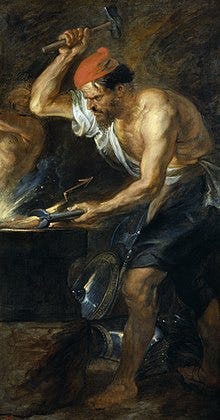Sunday Read: Hephaestus and the modern AI forge – #19
Series: "Mythology": How careful crafting and iterative design shape robust machine learning systems
“Mythology” Series:
Format: Each week we present a concise mythological story and draw direct parallels to contemporary AI concepts.
Goal: Highlight how modern technological dilemmas mirror ancient Greek tales, sparking interest about both subjects.
1. Mythological reference
In Greek mythology, Hephaestus is the god of blacksmiths, craftsmen, and invention. Working amid roaring furnaces and anvils, he creates indestructible armor, weapons, and magical contraptions for gods and heroes alike. Often depicted limping, Hephaestus overcame personal hardships through masterful craftsmanship—reminding us that ingenuity and perseverance can transcend physical limitations. Ancient sources highlight his skill in forging items of legendary durability and power, underscoring how invention shapes both everyday life and mythic narratives.
2. Parallel with AI
Crafting modern AI “forges”
Today’s AI frameworks—such as TensorFlow, PyTorch, and JAX—operate as modern “forges,” enabling engineers and data scientists to build and refine robust AI architectures. The parallels to Hephaestus’s workshop are evident:
Precision tools: Just as Hephaestus worked with fine-tuned hammers and tongs, AI developers rely on specialized libraries and machine learning toolkits.
Iterative design: Blacksmiths repeatedly heat, hammer, and quench metal; ML engineers iteratively train, test, and retrain models.
Durable output: Ancient Greek workshops produced gear that withstood harsh realities; similarly, modern AI solutions must remain scalable and reliable in ever-changing environments.
Lesson: forging robust AI solutions
Much as Hephaestus perfected the art of metalwork through meticulous technique, crafting effective AI tools demands careful design, testing, and optimization. In Greek and Roman Technology: A Sourcebook, editors Sherwood, Nikolic, Humphrey, and Oleson reveal how ancient workshops optimized processes and materials to achieve peak craftsmanship—mirroring modern DevOps and MLOps practices that prioritize efficiency and resilience.
Additionally, Andrew Ng’s Machine Learning Yearning suggests a systematic approach to model iteration and feature engineering, echoing the relentless tinkering of mythic blacksmiths. The careful forging of machine learning pipelines—selecting architectures, refining hyperparameters, and stress-testing algorithms—ensures the final product can weather real-world demands.
3. Reflections and questions to consider
Choosing the right tools
Which framework or library best suits our project’s needs, and how do we prevent “tool overload”?
Iterative improvement
How often should we “return our model to the forge” by retraining or refining architectures and hyperparameters?
Balancing innovation and reliability
When does experimenting with new ML techniques become risky if it compromises stability or performance?
Human craftsmanship
In a field increasingly defined by automation, how do we preserve the human touch of creativity and skilled problem-solving?
4. References
Homeric Hymns (Mythical sources describing Persephone’s descent and return, emphasizing agricultural cycles)
Adrienne Mayor, Gods and Robots: Myths, Machines, and Ancient Dreams of Technology
(Explores parallels between ancient tales and modern tech advancements)Greek and Roman Technology: A Sourcebook, edited by Sherwood, Nikolic, Humphrey, and Oleson
(Insights into ancient engineering and crafting methods.)Andrew Ng, Machine Learning Yearning
(Practical strategies for iterative development and error analysis in AI systems.)TensorFlow, PyTorch, JAX
(Modern AI “forges,” offering powerful libraries for model creation and training.)DevOps/MLOps best practices
(Focus on automation, monitoring, and resilience, paralleling the systematic approach of ancient workshops.)


